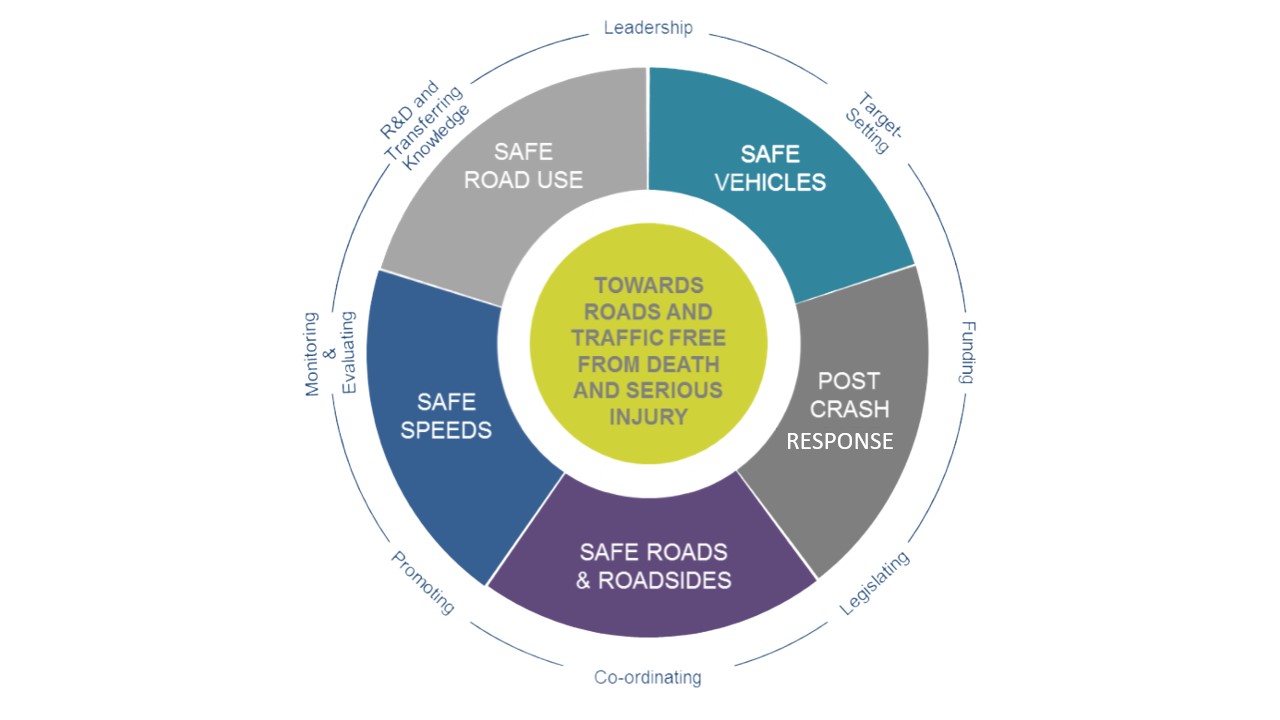

The latest Safe System Capacity Survey, run by Agilysis and supported by CIHT, reveals strong support for Vision Zero and road safety education, but more investment, leadership and collaboration are needed for a Safe System to be implemented in the UK.
Join other savvy professionals just like you at CIHT. We are committed to fulfilling your professional development needs throughout your career

Source: Loughborough University Design School Safe System Course, 2017, with PACTS modifications, 2022. Accessed online (https://www.pacts.org.uk/safe-system/) [28/11/23]
The Safe System is a holistic approach to road safety. Simply put, humans are limited and will make mistakes that cause road collisions. The Safe Systems approach recognises this and aims to put measures in place that reduce the likelihood of a collision occurring, and the severity of injury if it does.
This is achieved through the five pillars of action that make up the Safe System:
1. Safe road use;
2. Safe vehicles;
3. Safe speeds;
4. Safe roads and roadsides;
5. Post-crash response.
The Safe System is commonly seen as best practice around the world when it comes to road safety. However, despite many countries agreeing it is a good approach, very few have managed to implement it.
Agilysis recognised that ‘since 2010, road safety performance in Britain, and across many developing countries, has stagnated. After decades of dramatic progress in the safety of our streets, the period since 2010 has been marked by only marginal improvements’ and that a ‘common approach will only be achieved through honest appraisal of current performance and will require dialogue between those actors in all areas of the Safe System’.
Hence, Agylisis have run the Safe System Capacity Survey (supported by CIHT) for the last two years, to diagnose where we are as a sector on the journey to adopting a Safe System and bring to focus the next steps for us all.
The survey aims to gather data from all key stakeholders who are involved in reducing harm on our roads, including local authorities, the police, fire and rescue, transport authorities, charities and NGOs, amongst others.
In this article, CIHT provide an analysis of the recent results published by Agilysis.
Vision Zero is the belief that no death or serious injury is acceptable on our roads. The term is sometimes used interchangeably with Safe System, as the two principles are interlinked – we need a Safe System approach in order to achieve Vision Zero.
In the Safe System Capacity Survey, Vision Zero was the most commonly agreed target amongst organisations (42.5% of respondents), with a target for 50% reduction in deaths or serious injuries by 2030 being the second commonly agreed target (34.2% of respondents).
However, despite these positive aspirations, it was alarming to see a large proportion of respondents (19.9%) claimed to have no targets when it came to road safety, which could be something for further investigation.
Road safety education was the main area of focus for the majority of organisations surveyed.
During a webinar held by Agilysis this week on the Safe System Capacity Survey, Dan Campsall, Chairman at Agilysis, asked attendees to describe the type of road safety education activities their organisations use. Here, results showed social media to be the most common tool for road safety education.
CIHT are keen to understand CIHT Members’ views on whether road safety education is the key to implementing a Safe System. We also want to know what road safety education means to you and who should we be targeting this at - young drivers? School children? Fleet/professional drivers?
>>> CIHT Members can provide their opinions on this here
The survey also revealed that the biggest frustration amongst respondents was the lack of support from the UK Government. This is probably unsurprising to most people, as the UK Government hasn’t updated the nation’s Strategic Framework for Road Safety since 2011. And unlike the two previous National Road Safety Strategies, that 2011 document contained no road safety reduction targets.
When asked what support organisations need in implementing Safe System approaches, the most common answer given by the survey respondents was investment, with a broad consensus that this should be used in educational and training capacities.
Collaboration is key to implementing a Safe System in the UK, as the key stakeholders involved span many sectors and disciplines across the country, including National Highways, the NHS, air ambulance charities and victim support organisations, to name a few.
According to the Safe System Capacity Survey, 30.8% of organisations stated they work very closely with road safety organisations in neighbouring areas, with local authorities, police and fire and rescue services being the most common organisations in partnership.
However, the majority of respondents stated there is little (38.4%) or no (12.3%) collaboration with road safety organisations in neighbouring areas, identifying a clear target for future work in this space.
>>>You can access the full results of the Safe System Capacity Survey here.
Interested in road safety?
>>>CIHT Members can access the latest CIHT Masterclass on road safety education here.
For any press enquires please contact communications@ciht.org.uk
For any technical enquiries please contact technical@ciht.org.uk
Join other savvy professionals just like you at CIHT. We are committed to fulfilling your professional development needs throughout your career
Sign up to the APM Newsletter.
{{item.AuthorName}} {{item.AuthorName}} says on {{item.DateFormattedString}}: